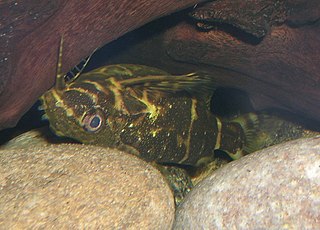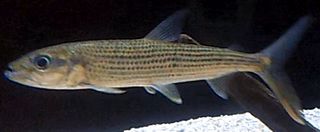
The African arowana or Nile arowana is a species of bonytongue. Despite being called an "arowana", the African arowana is more closely related to arapaimas, the only other members in the subfamily Arapaiminae, than the South American, Asian, and Australian arowanas in the subfamily Osteoglossinae. Compared to these, the African arowana has a more terminal mouth and is the only one that feeds extensively on plankton.

The fahaka pufferfish, also known as the Nile puffer, globe fish, lineatus puffer, is a tropical freshwater pufferfish found in the upper Nile, Chad, Senegal, Gambia, Geba, Volta and Turkana basins in West, Northeast and East Africa.

The name upside-down catfish is most commonly used by aquarists to refer to the mochokid catfish Synodontis nigriventris alternately known to ichthyologists as the blotched upside-down catfish or false upside-down catfish. However, a number of other fish may also be known by this name:

Synodontis batensoda, the upside-down catfish, is a species of mochokid upside-down catfish. It is unevenly distributed in inland waters across Africa from Senegal to Ethiopia, and is also known as a squeaker or giant upside-down catfish. It was originally described by Eduard Rüppell in 1832 in the paper "Continuation of the description and figure of several new fish, in the Nile. p1-14".

Synodontis membranaceus, known as the moustache catfish, is a species of upside-down catfish that is native to northern Africa. It was first described by French naturalist Geoffroy Saint-Hilaire in 1809 as Pimelodus membranaceus, from specimens obtained in the Nile River. The species name membranaceus refers to membranes present on the barbels of the fish.

The bayad, is a species of bagrid catfish from Africa.

Schilbe is a genus of schilbid catfishes native to Africa. Some are colloquially called butter catfish, though this may also refer to the Asian genus Ompok of the family Siluridae.

Synodontis nigrita, known as the false upside down catfish, is a species of upside-down catfish that occurs widely in northern Africa. It was first described by French zoologist Achille Valenciennes in 1840. The type specimen is in the Muséum National d' Histoire Naturelle de Paris.

Synodontis clarias, known as the red tailed synodontis, or the mandi, is a species of upside-down catfish that occurs widely in the waters of northern Africa. It was first described by Swedish zoologist Carl Linnaeus in 1758 as Silurus clarias. The original specimens were obtained in Egypt, near Cairo. The meaning of the species name clarias is not certain, but may possibly have been used to mean "bright" or "clear".

Synodontis filamentosus, known as the longfin synodontis, is a species of upside-down catfish that is native to the basins of the Nile, Volta and Niger Rivers as well as the Chad Basin. It was first described by British-Belgian zoologist George Albert Boulenger in 1901, from specimens obtained near the mouth of Lake No, on the White Nile in Sudan. The species name filamentosus comes from the elongated rays of the dorsal and caudal fins.

Synodontis geledensis, known as the Geledi squeaker, is a species of upside-down catfish that is native to Ethiopia, Kenya and Somalia where it can be found in the Lorian Swamp, the Shebelle and Ewaso Ng'iro rivers. It was first described by German zoologist Albert Günther in 1896, from specimens obtained near Geledi, on the Shebeli River in east Africa. The species name geledensis comes from Geledi, Somalia, the location where the first specimens were first found.

Synodontis serratus, known as the shield-head squeaker, is a species of upside-down catfish that is native to the Nile basin of the Democratic Republic of the Congo, Egypt, Ethiopia and Sudan. It was first described by German naturalist and explorer Eduard Rüppell in 1829, from specimens obtained near Cairo, Egypt. The species name serratus comes from the Latin word serra, meaning "saw", which refers to the serrated pectoral spines of the species.

Synodontis sorex is a species of upside-down catfish that is widely distributed in the rivers of northern Africa. It was first described by German zoologist Albert Günther in 1864, from specimens obtained in the upper Nile River, near Khartoum, Sudan. The species name sorex comes from the Latin word for shrew or shrew-mouse, the allusion was not explained. It possibly describes the pointed snout or the long, slender teeth.
Synodontis unicolor is a species of upside-down catfish that is endemic to the Democratic Republic of the Congo where it occurs in the area of Luapula-Mweru. It was first described by George Albert Boulenger in 1915. The original specimens were obtained in Kasenga, on the Luapula River in what is now the Democratic Republic of the Congo. The species name unicolor means "one color", referring to the uniform dark-brown coloration on the body and fins.

Labeo coubie, the African carp, is a cyprinid fish, widespread in Africa, where it occurs within the drainage basin of the Nile and in the Chad, Niger-Benue, Volta, Senegal and Gambia Rivers, as well as the Cross River and Cameroon coastal rivers. Furthermore, it is also known from East Africa and the middle reaches of the Congo. Records from the Zambezi drainage need confirmation.

The vundu is a species of large airbreathing catfish found widely in rivers and other freshwater habitats of sub-Saharan Africa, as well as the Nile. It is also called the sampa, cur, lenda, or certa.
Schilbe intermedius or the silver butter catfish is a widespread species of African catfish. It seems closely related to Schilbe uranoscopus and these two species are sympatric over part of their ranges.

Hydrocynus forskahlii, the elongate tigerfish, is a species of predatory characin from the family Alestidae which is found in northern and western Africa.

Alestes baremoze, the pebbly fish or silversides, is a species of characin fish from the freshwater systems of northern and western Africa. It has some importance as a commercially exploited food fish.

The Nile minnow is a species of cyprinid fish found the Nile, Omo, Niger, Bénoué, Volta, and Senegal Rivers, and the Lake Chad basin. It was described by Léon-Daniel de Joannis in 1835.



















